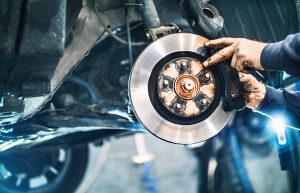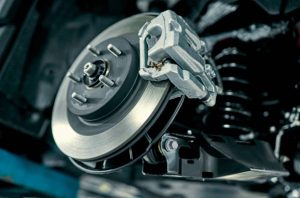Understanding Brake Pads

Brake pads are an essential component of your car’s braking system. They are responsible for converting the kinetic energy of the car into thermal energy through friction, thus slowing down or stopping the vehicle. Understanding the role and function of brake pads is crucial when selecting the right type for your car.
Types of Brake Pads
Brake pads come in various types, each suited for different driving conditions:
| Type | Description |
|---|---|
| Ceramic | Ceramic brake pads are known for their longevity and quiet operation. They produce less dust compared to other materials. |
| Semi-metallic | These pads contain metal fibers and are highly durable. They offer excellent performance in a variety of conditions. |
| Organic (Non-asbestos Organic – NAO) | Made from various fibers bonded with resin, organic pads are softer and quieter though they wear faster under heavy use. |
| Low-metallic NAO | These pads contain small amounts of copper or steel to better conduct heat, offering improved braking with a little noise. |
Factors to Consider When Choosing Brake Pads

Selecting the appropriate brake pads involves several considerations:
- Driving Conditions: Consider the typical driving conditions — city driving, highway, mountainous or off-road — and select pads that match those conditions.
- Material: Decide on the material based on balance between performance, longevity, and noise.
- Vehicle Type: Heavy vehicles, sports cars, and everyday sedans may require different pad specifications.
- Budget: Balance cost with quality to ensure you get reliable pads without unnecessary expenditure.
- Manufacturer Recommendations: Always consider manufacturer guidance to maintain warranty and optimal performance.
- Performance Needs: If you tend to drive aggressively, you might want performance-oriented pads that offer better bite and heat dissipation.
For more detailed guidance, check out our in-depth article on selecting brake pads.
Conclusion
Choosing the right brake pads is essential for the safety and performance of your vehicle. By considering the type of vehicle, driving conditions, and personal driving habits, you can select the ideal brake pads that will keep you safe while maximizing the efficiency of your braking system.
Parking Brake Cables: How They Work and Common Failure Symptoms
The parking brake — often called the handbrake or emergency brake — plays a crucial role in vehicle safety. While many drivers think of it as a simple lever or button, the true work happens underneath the car, where parking brake cables transmit mechanical force to the rear brakes. These…
Top Signs Your Brake Hose Is Failing and Needs Replacement
Brake hoses are small but essential components of your vehicle’s braking system. They carry high-pressure brake fluid from the master cylinder to the brake calipers or wheel cylinders. Because they must withstand movement, heat, pressure, and harsh road conditions, brake hoses can deteriorate over time — sometimes without obvious warning….
Brake Hoses Explained: Types, Materials, and How They Affect Braking
Brake hoses may seem like small, simple components, but they play a crucial role in ensuring safe and responsive braking. These flexible tubes carry pressurized brake fluid from the master cylinder to the brake calipers or wheel cylinders. Without reliable brake hoses, even the most advanced braking system cannot perform…
Top Signs Your Brake Shoes Need Replacement (Before They Fail)
Brake shoes play a critical role in the braking performance of vehicles equipped with drum brakes, especially on the rear axle. Although drum brake systems are durable, brake shoes wear gradually over time — and failing to replace them early can lead to reduced braking power, damaged drums, and even…
What Causes Premature Brake Shoe Wear — and How to Prevent It
Brake shoes are designed to last tens of thousands of kilometers, but in many vehicles they wear out much faster than expected. Premature brake shoe wear doesn’t just increase maintenance costs — it can also compromise braking performance, reduce handbrake efficiency, and even damage brake drums. Understanding the causes of…
How Car Brake Shoes Work: Complete Guide for Beginners
Car brake shoes are essential components of drum brake systems, found in many rear-wheel setups and some trucks or older vehicles. Although disc brakes dominate modern cars, brake shoes still play a crucial role in overall braking balance, parking brake operation, and vehicle safety. This guide explains how brake shoes…
How to Measure and Inspect Brake Drums for Wear
Brake drums play a crucial role in many vehicle braking systems. Over time, wear and tear can compromise their effectiveness, leading to reduced braking performance, vibration, or even failure. Regular inspection and proper measurement help ensure safety and prolong drum life. This article will guide you through how to measure…
Maintaining Your Brake Drums: Tips for Longevity and Performance
Your vehicle’s braking system is one of its most critical safety components — and if your car or truck uses brake drums, proper maintenance is key to keeping them performing at their best. While disc brakes dominate modern vehicles, drum brakes are still widely used, especially in rear braking systems,…
Choosing the Right Brake Drum for Your Vehicle
When it comes to vehicle safety, few components are as vital as the braking system. While disc brakes have become standard in many modern cars, brake drums remain widely used — especially in the rear braking systems of small cars, commercial vehicles, and heavy-duty trucks. Selecting the right brake drum…
Brake Caliper Materials Explained: Steel, Aluminum, and Composite Options
Brake calipers are among the most critical components of a vehicle’s braking system, directly responsible for clamping the brake pads onto the rotor and generating the friction needed to slow or stop your car. However, not all calipers are built the same. The material from which a brake caliper is…